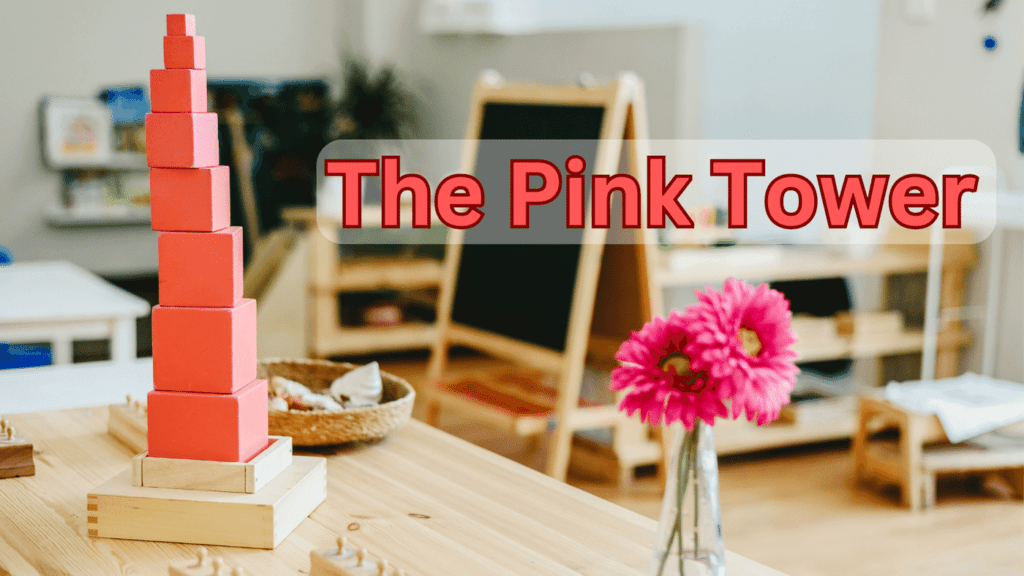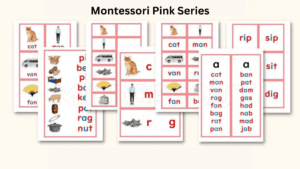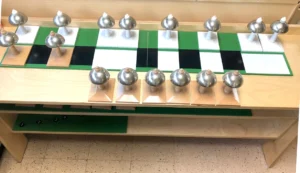The Montessori pink tower is a sensorial lesson designed for primary-level (3-6-year-old) children. The pink tower helps them to understand the concept of order.
“I found that a sense of order was necessary in life, and this sense of order was awakened in the child through the right kind of discipline, which it had been found to be possible to obtain in no other way than by appealing to his sense of order.” – Maria Montessori (from her speeches)
What is Montessori Pink Tower?
Pink Tower is a classic sensorial material that comprises ten solid wooden cubes of graduated sized varying from 1 cm³ to 10 cm³. Each cube is painted pink and perfectly fits on top of one another to form a tower starting from the largest cube at the bottom and the smallest at the top.
Pink Tower in Montessori is specifically designed to enhance a child’s visual discrimination (size, and shape), hand-eye coordination, concentration, fine motor skills and sense of order.
Why Montessori Pink Tower is Pink?
The pink color of the Pink Tower serves as a visual cue to draw attention to the varying sizes of the cubes and their sequential arrangement. By providing a uniform color for the cubes, the child’s focus is directed towards the visual discrimination of size, rather than being distracted by different colors. The pink color also adds an element of aesthetic appeal, capturing the child’s interest and engagement while exploring the material.
What are the Benefits of Pink Tower?
Here are some benefits of using the Montessori pink tower:
- Develops fine motor skills: As children stack the blocks, they use their small muscles to grip and lift the blocks. This helps to strengthen their hands and fingers, which are important for tasks such as writing and using utensils.
- Improves hand-eye coordination: Children need to use their hands and eyes together to stack the blocks in order. This helps to improve their hand-eye coordination, which is important for many activities, such as sports and playing instruments.
- Teaches about order, size, and shape: As children stack the blocks, they learn about the concept of order. They also learn about the different sizes and shapes of the blocks. This helps to develop their understanding of basic math concepts.
- Promotes concentration and focus: Stacking the blocks can be a challenging task for young children. It requires them to concentrate and focus on the task at hand. This helps to develop their attention span and ability to focus on a task.
- Encourages independent play: The Montessori pink tower is a self-correcting material, which means that children can learn to use it independently. This helps to encourage them to play independently and develop their problem-solving skills.
Overall, the Montessori pink tower is a valuable tool that can help children develop important skills. It is a simple material that can be used in a variety of ways to promote learning and development.
Why You Should Incorporate Pink Tower into Learning Environment?
By incorporating the Montessori Pink Tower into the learning environment and engaging in related activities, children develop foundational skills in mathematics, concentration, coordination, and order. The Pink Tower provides a stimulating and hands-on learning experience that cultivates a love for learning and lays the groundwork for future academic success.
How to Introduce Montessori Pink Tower to the Child?
To introduce the Montessori pink tower to a child, follow the below steps:
- Invite the child to bring the Pink tower from the sensorial section to the table.
- Ask the child to put each block on the working mat and count them.
- During the presentation, the adult uses appropriate vocabulary to describe the sizes, such as “biggest,” “smallest,” and “in between,” helping the child develop a rich mathematical language.
- Once the child masters to identify the biggest cube to the smallest cube, show them how to stack the blocks vertically from largest at the bottom and smallest at the top.
- After the initial presentation, encourage the child to explore the Pink Tower independently. They can freely build and rebuild the tower, experiencing the visual and tactile sensations of the cubes.
Tip: While introducing the concept of smallest and biggest and the order, you can also sing a song or chant a rhyme to help the child remember the order of the blocks.
5 Activities Related to Pink Tower
Here is the list of 5 activities that make the pink tower activity more fun:
- Size Sequencing: Encourage the child to arrange the pink tower cubes in a line from largest to smallest or vice versa. This activity reinforces the concept of size and helps develop visual discrimination skills.
- Blindfolded Tower Building: Challenge the child to build the pink tower while blindfolded. By relying solely on their sense of touch and spatial awareness, they will further enhance their fine motor skills and develop a deeper understanding of the relative sizes of the cubes.
- Tower Extensions: Encourage the child to explore creative extensions with the pink tower. They can incorporate other sensorial materials, such as knobless cylinders, to build patterns or structures around the tower, enhancing imaginative play and spatial reasoning skills.
- Counting and Quantity: Ask the child to count the number of cubes in the pink tower. Then, provide them with objects or numeral cards to match the number of cubes. This activity helps develop number recognition, counting skills, and the concept of one-to-one correspondence.
- Group Tower Building: Invite multiple children to collaborate and build a giant pink tower using several sets of cubes. This activity promotes teamwork, communication, and problem-solving skills as they work together to create a tall and stable tower.
FAQs
- What is the purpose of the Montessori Pink Tower?
The Montessori pink tower is a classic Montessori material that has been used for generations to help children develop important skills. It is made up of ten blocks of graduated sizes, from the largest at the bottom to the smallest at the top. Children learn to stack the blocks in order by size, which helps them develop their fine motor skills and hand-eye coordination. They also learn about order and shape as they place each block on top of the other.
- What is the indirect aim of the Pink Tower?
The Pink Tower is a Montessori toy that helps children develop fine motor skills, hand-eye coordination, and problem-solving skills.
- Why is it called Pink Tower?
The Montessori Pink Tower is called so because the wooden cubes that make up the tower are painted in shades of pink. The specific choice of color is not mentioned in Maria Montessori’s writings, but it is believed that the color pink was chosen to create a visually consistent and appealing material for the child. By using a uniform color, the child’s focus is directed towards the sizes and dimensions of the cubes, allowing them to develop their visual discrimination skills. The pink color also adds a touch of aesthetic appeal, making the material attractive and engaging for young learners.




